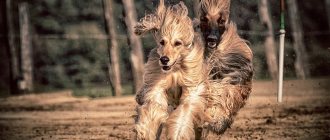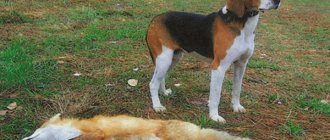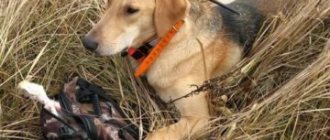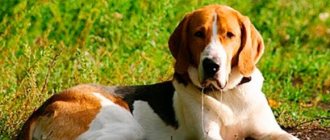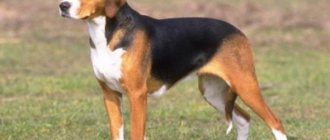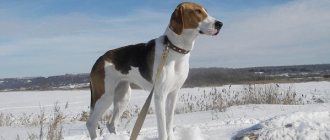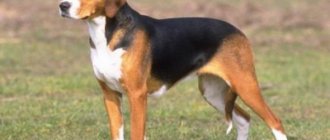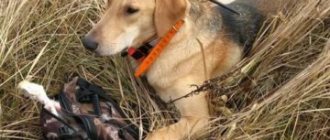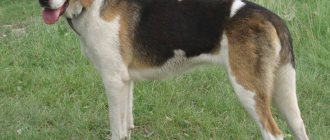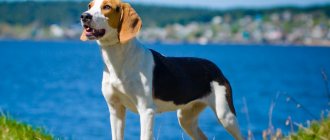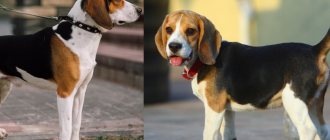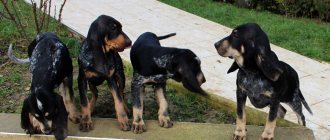Description of the Russian Hound breed
Popularity 112th place among 263 dog breeds
Lifespan:
12-16 years old
Breed group:
Hounds
Height:
males: 58-68 cm, females: 55-65 cm
Country of origin:
Russia
Average price:
15-20 thousand rubles
Weight:
25-35 kg
Latest articles Cat health
Rabies vaccination for cats: choice of vaccine, necessity, schedule 01/22/2022 4 0 0
Selection and adaptation
TOP 20 best cat breeds for families with children 01/22/2022 25 0 0
Key facts
Despite their average size, these animals are practically unsuitable for keeping in an apartment, as they do not tolerate limited space well. In addition, dogs do not get along well with other pets, becoming potentially dangerous to them.
The characteristics of the Russian Hound breed say that the dog has a flexible and sharp mind - this allows you to remember all the commands almost the first time. The character contains pronounced leadership qualities, which makes the animal stubborn; it sometimes tries to resist its owner.
The hunting qualities of these dogs are legendary. They are so keen on following the trail that they can go great distances while hunting. In addition, hounds can change the pitch and timbre of their tone, reacting to different situations with different tones of barking.
Outside the hunting season, the pet requires active exercise. Walks should take a total of at least 3 hours a day. Otherwise, the dog will show its character and may destroy the house.
These dogs belong to the category of giant breeds and surprise with their size. The height at the withers of a male is 58-68 cm, and that of a female is 55-65 cm. The weight of a Russian hound ranges from 30-35 kg for males and 23-27 kg for females.
The average life expectancy of a Russian hound is 13-16 years. This is a very long period for an active breed.
An interesting fact is that the International Canine Organization refused to accept the standard and description of the Russian Hound breed, so the animals are registered only in the RKF system.
Owner reviews
According to reviews from the owners of the Russian piebald hound, such a dog is calm and balanced, and is also capable of not only weighing, but also calmly considering all its actions. The breed is very friendly and is not overly aggressive, so it is not used as a guard dog.
Despite its unpretentiousness in terms of behavior, the optimal place for keeping a Russian pinto hound is considered to be a country house.
Dogs of this breed very much need sufficient and regular movement, as well as intense and well-calculated physical activity, which will require not too limited space.
Video
History of the origin of the Russian hound
There are two versions of the origin of the Russian hound breed. According to the first, it entered the territory of our country along with the Mongol-Tatar invaders. According to the second, this is the result of crossing foreign hounds with huskies. The first mention of dogs was recorded in the 12th century, and in the 19th century animals began to actively participate in exhibitions.
By the 20th century, the type was almost completely formed. But during the Civil War, the number of representatives of the breed decreased significantly, and work with the standard had to start almost from scratch. The process was also complicated by the fact that in Tsarist Russia there were a huge number of species of hounds, pointers and greyhounds, which were periodically crossed with each other.
In 1925, the first breed standard was described, and in 1939 a law came into force prohibiting the breeding of all types of hound breeds with the exception of Russian and piebald.
The Russian hound is evaluated according to working tests, a complex of which was approved in the same 1925.
Pros and cons of the breed
When you decide to get a hunting dog, in this case, a Russian hound, keep in mind that from birth it has a pursuit instinct.
The desire to hunt in a hound is so strong that it is impossible to get rid of it, except perhaps to pacify it a little.
Therefore, if you need a watchdog or want to place a pet in an apartment, it is better to refuse the Russian hound.
This is a breed that is ideal for hunters or people who live outside the city and like to spend a lot of time outdoors.
The main pros and cons of the Russian Hound breed are presented below.
Advantages:
1. Devotion. 2. Endurance. 3. Friendly attitude towards all family members. 4. Easy care. 5. Not expensive to maintain. 6. Excellent hunting instinct. 7. Easily tolerates cold and heat. 8. Good health.
Appearance of a Russian hound
The breed standard in the Russian Canine Federation system was formulated and adopted on May 13, 1981. The Russian Hound is not accepted in the FCI system.
General impression
In the photo of the Russian hound and upon a quick examination, it is noticeable that the dogs have a wolf-like appearance. The height is slightly above average, the body type is strong. Defects include a stretched body, short or long legs.
Cowardice or aggressive behavior towards humans is considered a psychological defect and prevents the admission of such animals into breeding.
Head
It has a wedge-shaped shape, is quite dry, strong, and fits into the proportions of the body. The occipital protuberance, like the brow ridges, is practically not pronounced. The transition of the forehead to the muzzle is smooth, but at the same time clearly defined.
The nose is large, wide, and black. The lips are narrow, dry, and fit tightly to the jaw bones and dentition. Scissor bite, 6x6. The dentition is clear, even, and well developed.
The ears are triangular in shape, hanging in a hanging position, medium-sized relative to the size of the head, and fit tightly to it.
The eyes are dark brown in color and almond-shaped, slightly slanted.
Neck
The length of the neck is equal to the length of the head. Has a well-developed muscular system. The neck set is low.
Torso
Animals have a strong body, evenly covered with well-developed dry muscles. The chest is wide and deep set - the lowest point is below the dog's elbows.
The withers stand out noticeably above the level of the back line. The top point of the croup is 1-2 cm below the corresponding point of the withers.
The back is strong and muscular. The loin is shortened and has a slight dome-shaped elevation above the top line. The croup is strong, moderately sloping. The belly is lean.
Forelegs
When viewed from the front, they are parallel to each other and perpendicular to the surface, dry, muscular. Elbows are parallel to each other and point clearly back. The humeroscapular angle is 100-110 degrees. The pasterns are strong. The paws have clenched toes of a dark color.
Hind limbs
The hind legs are strong, dry, covered with well-developed muscles. The angle of the hock joint is significantly pronounced. The shins are long.
Tail
It is thickened at the base and gradually tapers towards the tip. When relaxed, it should not fall below the hock joint. When tense, it rises to the level of the back line. A disqualifying fault is excessive length or lack thereof, or irregular shape.
Movements
Movements are free and sweeping.
The main gait is gallop or wide active trot.
Wool
It is of medium length, shortened on the head, ears and limbs. A dense scruff forms around the neck. The dense dense undercoat is well developed.
Color
The standard allows three colors of the Russian hound:
- black-and-white;
- scarlet;
- gray with tan.
The tan marks have a faint yellowish or whitish tint. Small white spots in the neck area are acceptable.
Size
The height of a male dog at the withers should be no lower than 58 cm and not exceed 68 cm. The optimal height of a male Russian hound is 64-66 cm. The female should be no lower than 55 cm, but not exceed 65 cm.
The weight of males should not fall below 30 kg, females - below 25 kg. According to the size table, the Russian hound is a large breed.
Any deviation from the official breed standard may reduce the show score. Disqualifying defects do not give the dog the right to participate in All-Russian exhibitions and be used in breeding.
Character of the Russian hound
The animals have a fairly calm, balanced character. They can rightfully be called real hard workers - when they go hunting, they devote themselves entirely to work, unraveling the most intricate traces and walking enormous distances to find their prey.
Dogs get along well with all family members, patiently putting up with all children's pranks. But they don’t get along with other pets. In addition, during walks it is necessary to carefully monitor your pet, since they see cats and small breeds of dogs as potential prey.
Dogs are completely unsuitable for guard duty. Outside the hunting season, you can keep your pet busy with various types of sports training, for example, agility or freestyle. This way the dog will throw out the accumulated energy with great interest.
They are very wary and distrustful of strangers and try to avoid contact with strangers. In general, the character of the Russian hound can be called pleasant and reserved.
General characteristics of the breed
Despite its large size, the Russian hound dog breed does not have a tendency towards aggression. Sometimes this turns against the owners, since the pet will also be friendly towards ill-wishers.
Owners of hounds often complain about this quality, since due to their low security qualities there is a high probability of being harmed by thieves or robbers.
According to its external description, it looks like a husky and many other hunting breeds. The most characteristic feature is long limbs, a toned body and small, drooping ears. With their habits during the hunting period, they resemble predatory animals, especially wolves. They are also associated with these animals by another feature of their physique - high forwardness.
The breed standard is accepted only in the territory of the former Soviet Union
Education and training
You should start raising and training a Russian hound at the age of three to four months. The main emphasis in the process is on the development of hunting instincts and skills.
Toilet training must be systematic. Every day at the same time you need to take the puppy for a walk. As they get older, the number of walks decreases to two or three per day.
Puppies usually do not chew furniture and shoes in the house if they have enough physical activity. If the dog's mobility is limited, the apartment may suffer.
The first step in training a dog is to familiarize it with the basic commands, without which no training process is complete. It is worth remembering that before starting work you need to let your pet “let off steam”. A dog that has not received sufficient physical activity will be distracted every now and then in the process of learning techniques.
The next stage is to accustom the dog to the sound of a hunting horn. Many experts recommend establishing a strong “sound = food” connection in your dog, that is, blowing the whistle immediately before eating. This way the pet will form the necessary stereotype.
After the hound turns 10 months old, it is necessary to begin training. The methods used are standard and applicable to all hound breeds. It is best to conduct classes early in the morning along the trails, so that the animal learns to clearly identify the desired smell and, in the future, does not confuse it with anything else.
If you plan to train the dog to use a “bow” (double collar), then it is best to pair it with an experienced hound, who will work clearly and competently, setting the required pace.
Mating
Breeding mating for Russian hounds is mandatory for the formation of a single livestock and an entire breed line. In their absence, the breed is not recognized by international organizations. Therefore, it is recommended to bring pets through official breeders, obtain certificates for mating and fill out special forms.
The owners of the bitch and the dog must agree in advance on a specific date. The boy's owner sets the price. He can take one puppy or a percentage of the cost of the dog. If the female turns out to be empty, the contract is reset and the amount is not paid.
- To determine the approximate date you need to know the girl’s cycles.
- Puberty comes early to puppies (8-10 months). The first heat usually occurs at this time.
- It is recommended to start mating at 2 years of age, when dogs are able to bear healthy offspring.
- On days 13-15 of the third heat, some symptoms should appear.
- The previously swollen and hard loop becomes loose and soft, the discharge becomes lighter, the female invites the male with her tail, and becomes playful or aggressive.
- On the appointed day, the animals are walked together and taken to the territory of the male dog. The girl will allow you to do the cage when she is ready.
- During the uncoupling (the first time), the animals are helped: they support the female under the belly, and the male is directed into the loop. Sometimes a specially trained person is invited.
- The absence of a lock is not a reason to worry. This does not mean that the act was unsuccessful and the female is empty.
- Fixative mating is carried out after 48 hours.
Health and diseases of the Russian hound
The most important step in maintaining the health of a dog working outdoors is regular routine vaccinations, cyclic tick treatment and a thorough examination for injuries and damage after hunting.
Possible diseases
The most terrible infectious disease to which all fox hunters are exposed is rabies. Prevention is through annual vaccinations. Means to combat rabies have not yet been invented, so the outcome of infection is one – death.
In addition to this dangerous virus, there are a number of diseases that are inherited by the hound:
- hip dysplasia;
- degenerative myelopathy.
Hip dysplasia is a 21st century “disease” in the dog industry, affecting a huge number of breeds. Experienced breeders, when choosing a pair for mating, always request the results of special tests in order to protect future puppies from birth defects.
A dog susceptible to this disease is simply unable to move actively, much less participate in hunting. She is not allowed for breeding.
Degenerative myelopathy is characterized by the gradual loss of white bone marrow. There is no treatment provided, so maintenance therapy remains until the end of life.
In addition, hunting dogs often seriously injure the mucous membrane of the eyes on branches and sharp grass. You can prevent complications by examining the animal after each active walk.
The breed is not prone to food allergies, so the pet's diet can include a large amount of varied food.
Reproductive health
Individuals older than 12 months are allowed for breeding. The optimal age for the first mating in a male is 10-12 months; in a female, the second mating is in heat. It is recommended to plan mating outside the hunting season.
During the normal course of pregnancy, which lasts 56-63 days, childbirth proceeds easily, without human intervention. There are 2-4 puppies in the litter during the first pregnancy, and 4-6 puppies during subsequent pregnancies.
Females have good maternal instinct, providing their offspring with warmth and food. The owner's help will be required only in exceptional cases.
If the dog is completely healthy, sterilization is not recommended. Surgery is permissible only if there are medical indications.
Health
On average, the Russian hound lives 12-13 years, but there are cases of longevity when representatives of this breed reach the age of sixteen. Lifespan directly depends not only on heredity, but also on how much the owner cares about the animal.
The owner must provide the hound with a balanced diet and proper maintenance. Treatment with drugs against skin parasites, deworming, and vaccination are mandatory. A preventive examination at a veterinary clinic is recommended once a year.
By nature, the Russian hound has good health and strong immunity. Representatives of the breed get sick extremely rarely, but a predisposition to the following health problems is still observed:
- Conjunctivitis is an inflammation of the connective membrane that covers the outside of the eye. More often seen in young dogs.
- Myositis is inflammation of muscle tissue.
- Myelopathy is a severe progressive neurodegenerative disease that leads to paralysis.
- Hyperthermia is a syndrome that manifests itself only when a number of drugs are used during anesthesia.
- Joint dysplasia – at the first stage it is accompanied by pain in the joints; at the last stage the dog may lose the ability to move.
Features of feeding and diet
The breed is extremely unpretentious in food. A huge plus is the absence of food allergies in animals.
If you decide to feed your puppy natural food, then you should use lean meats and poultry, and avoid bones, especially tubular ones. The diet must include fruits and vegetables, cottage cheese and chicken eggs, fish, and cereals.
You also need to remember about vitamins - your veterinarian will recommend them. There are currently a large number of dietary supplements for animals on the market, from which you can choose special multivitamins for puppies.
From 3 to 4 months, the number of feedings is 6 times a day. From 4 months, the number of feedings is reduced to 5, then to 3, and from 18 months, dogs are fed twice. To calculate the daily amount of natural food, you can use the standard formula: up to 6 months. food should make up 6–7% of the dog’s weight, older than 6 months. - 3-3.5%.
When feeding “dry”, the serving rate is indicated on the package. Usually it is 1.5-2 times less than the volume of daily natural food.
During periods of active exercise, it is recommended to slightly increase the amount of food or use specialized dry food for dogs experiencing increased physical activity.
If you want to raise a dry dog, then the breeder will give you an answer to the question of what food to feed the puppy. He will tell you which food is best suited for this breed, how many times to feed a one-month-old puppy, how the diet changes as the dog ages, and whether it is possible to give the baby kefir and cottage cheese. In most cases, preference is given to holistic or super-premium food, which contains only natural ingredients.
Nutrition
Russian hounds are quite picky eaters. They will be happy with anything you put in their bowl. Of course, each dog has its own preferences, as well as character or other characteristics. But they are definitely not picky when it comes to food.
Experienced breeders recommend feeding Russian hounds with professional premium and super premium wet or dry food.
If you decide to keep your pet on dry food, be sure to ensure that he has clean water available at all times. If the dog is not yet accustomed to the food, then give it in a soaked form. You can mix dry food with wet food. The main thing is that it is from the same manufacturer.
When choosing industrial food for your Russian hound, rely on the following tips:
- It should not contain too much phosphorus, as it negatively affects the dog’s nervous system;
- The percentage of protein for adult animals should not exceed 26%, and for puppies - 30%;
- For active dogs, the food should contain enough carbohydrates;
- Do not change food too often, introduce new ones gradually;
High quality food contains all the necessary vitamins and microelements and is well balanced. Therefore, there is no need to take additional supplements if your dog is completely healthy.
Care and maintenance
The Russian hound is extremely unpretentious in care and maintenance. She feels great in warm and cool weather outside, happily spends several hours in active games when the temperature is below zero, and prefers to sleep on the floor over warm, thick bedding.
Modern breeders are of the opinion that excessively comfortable living conditions will negatively affect the working qualities of the breed, or rather, weaken the health and endurance of the animals.
If you live in a private house, the optimal place for a dog would be an insulated kennel, the floor of which is lined with hay or straw. You should not put your dog on a chain. The best solution would be an aviary. For pregnant and lactating bitches, it is necessary to allocate a separate area, closed from human eyes and protected from drafts.
Keeping him in an enclosure does not replace a full three-time walk. It is advisable to go with your pet to a place where it is possible to let him off the leash, give him a good run and repeat various commands.
The Russian Hound's coat does not need to be combed with a comb, but a massage with a special rubberized mitten will not hurt. In addition to removing dead undercoat, it will increase blood circulation in the skin. It is recommended to wash your pet as it gets dirty, not forgetting to dry it completely, especially for outdoor animals.
You should check your dog's eyes daily for discharge and tearing. The paw pads must be inspected for splinters, which can cause significant discomfort to the pet.
Ears should be cleaned no more than once every ten days. Nail trimming occurs at the same frequency.
Many owners are concerned about how to care for their pet's teeth. To prevent the formation of tartar, you can use special products in the form of treats or special drops, which should be added to a bowl of water daily to cleanse the mouth of plaque and unpleasant odor. In addition, you can pamper your pet with a raw large joint, for example, a knee or beef tail.
Key points in training
These dogs are hunters by genetics and temperament. They are serious, stubborn and independent. To raise a good pet you need to have a strong character. A beginner cannot cope with such a dog.
Such a dog needs to be trained from 3-4 months , but raised from birth. The pet must know that the person in the house is in charge and must be obeyed. To do this, you should not allow the puppy to jump on the owner’s furniture, beg, manipulate, or whine for no reason. The owner always needs to remain a leader and show this to the dog. But you cannot resort to harsh methods: hitting your pet, insulting, humiliating. To show the hound that she is wrong, you can pull the collar, deprive her of treats or food.
A hunting dog must undergo several training courses at a training school. If the animal lives in the city, then the “Dog in the City” training will be the basis. In addition, the hound must be taught to hunt correctly: not to kill or bite game, listen to the owner and sound signals (whistle, trumpet, claps).
Basic commands are learned by the puppy after he has learned his name. By 4 months, the dog should respond to its name, know the walking and feeding schedule, and respond to basic commands: “No”, “Place” . Then you can train reflex reactions to other words: “Sit”, “Voice”, “Quiet” .
Read about how to properly train a dog in the article: “Training a puppy: effective methods from dog handlers, learning commands at home.”
Tips for choosing a puppy
You need to approach the choice of a new family member as seriously as possible. After all, the dog must meet all the requirements of the standard both externally and behaviorally.
Before you go to see the litter, talk to the breeders. Find out as much information as possible about the parents of the Russian Hound puppy - character, appearance, behavior in society, the presence of titles, hereditary diseases, behavior during hunting and working tests will be passed on to the baby.
Check the age of the bitch - you should not take a pet if the mother is too young and old. Ask the breeder to show the bitch, evaluate the visual condition of the dog. The dog may be a little thin while nursing puppies, but interest and activity should remain.
Carefully examine the little hound - it should be active and curious. Stiffness, fear or unmotivated aggression are unacceptable.
The coat and skin should be clean, free of rashes, irritations or bald patches. Eyes – clean, clear, moist. Scissor bite, teeth small and sharp. Males must be checked for the absence of cryptorchidism. Examine the puppy for umbilical and inguinal hernias.
You should purchase a dog from a breeding kennel with a full package of documents - this includes a puppy card and a veterinary passport with vaccination marks. By purchasing a dog from a professional breeder, you receive a guarantee that the dog meets the standards of this breed and is allowed for exhibitions and breeding.
Before buying a baby, you need a consultation with a breeder, who will tell you in detail what points you should pay attention to and what questions you should ask the seller during a personal meeting, and may also recommend good breeding nurseries.
How to choose a puppy?
Choosing a puppy of any breed is a very responsible matter. After all, he will become a new member of your family. You should be especially careful when choosing a Russian hound if you plan to go hunting with it.
When choosing, it is better to be present in person, so visit the nursery to look at the babies, their mother and the conditions in which they are kept. Watch the dogs. They must be active and eat with appetite. Pay attention to the puppy's coat, it should be shiny and smooth.
The breeder must show you all the necessary documents, including the passports of the puppies' parents. When your new pet finds itself in a new place, you need to follow all the advice and instructions of the breeder so that the puppy successfully adapts.
For future hunters, the requirements are more stringent than for those dogs that will not be used for this. Take a closer look at the puppy's build; it should be large, with straight limbs, without a saggy belly or arched back. Of course, a lot depends on training, but health, pedigree and inclinations will play an important role in character formation.
How much does a Russian hound cost?
Working dogs, in most cases, are quite expensive. It is impossible to name the exact price - it is directly related to such factors as the presence of a litter’s pedigree, as well as the title status of the parents and their level of passing working tests.
The average price of a Russian hound is 15-20 thousand rubles. Large well-known breeding nurseries offer puppies for this price. Their dogs have high show scores and regularly participate in hunting.
On the Internet there are advertisements for the sale of puppies, the price of which does not exceed 5,000 rubles. This is due to the fact that hunters breed purebred dogs without filling out documents for the puppies. Buying such a dog does not guarantee its purebred, since two different, closely related breeds are often mated.
Do you like the article? 0
Nicknames
First of all, the owner should like the nickname, be easy to pronounce and completely suit the dog. Beautiful nicknames that aptly indicate character traits or appearance sound good. Examples of nicknames for the Russian Hound dog breed:
| For boy | For girl |
| Bass | Flute |
| Ringing | Arrow |
| Alto | Yula |
| Ataman | Hera |
| Baron | Storm |
| Scythian | Nymph |
| Rock | Julia |
REFERENCE. It is not customary for dogs of this breed to be called too cute or funny names.
Proper education and maintenance in the right conditions will allow the Russian hound to become a first-class hunting partner and a devoted friend in life. Spend more time with your pet, and then he will give you many unforgettable experiences.
